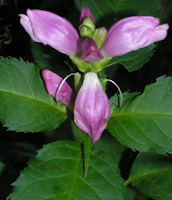This week's bloomlist for Wildflower Island is at the end of the post, and Bonnie's
pictures can be found HERE. Peterson names are used for consistency wherever
possible, and comments and clarifications are welcome in the comments section.
Sept. 6th revisions in red.

Couple of things to mention.
On the Island, be careful not to step on the Bicknell’s Cranesbill, which is in the middle of the path at no.10. Also, near the Bayberry (on Lakeview Point; see map right) is a very young evergreen we hadn’t noticed before. Mat thinks it’s a Red Cedar.
I’m having trouble identifying a couple of things. Last year I did some research on some late-blooming plants, which I should have looked at before doing the list today.
Regarding the Red Turtlehead, Peterson gives the Latin Chelone lyoni, but mentions a C. obliqua (not shown) with narrower leaves. (Wiki). Illinois Wildflowers has this description, which is what swings me in the direction of C. obliqua, in addition to the seemingly narrower leaves:
Pink Turtlehead is the only native Chelone spp. (Turtlehead) in Illinois with pink to deep rosy pink flowers. It is an attractive plant with turtlehead-shaped flowers. The other native Turtlehead within the state is Chelone glabra (White Turtlehead), which has white (or slightly pink) flowers and shorter petioles (less than ¼”). Sometimes Chelone lyonii (Lyon's Turtlehead) is grown in flower gardens, although it has not naturalized within the state. This species is native to the Appalachian mountains in the SE. Lyon’s Turtlehead has flowers that are about the same color as those of Pink Turtlehead, but it has wider leaf blades and longer petioles (½–1½" long). Other common names that refer to Chelone obliqua include Rose Turtlehead, Purple Turtlehead, and Red Turtlehead. http://www.illinoiswildflowers.info/wetland/plants/pink_turtlehead.htmThe leaves of theC. lyonii are broader (picture from GoBotany):
And there is talk on the internet of it being a more southern plant.
On WFI, there’s a single blue-violet bloom – 3 blooms on Sept. 6, and more than one plant – on something I’m guessing is a Late Purple Aster Symphiotrichum patens. It’s one of several asters in Peterson’s blue pages whose leaves clasp the stem (p. 356).
I am not alone in being hesitant to I.D. this aster. On the Wildflowers of the United States page, the botanist writes: “It is with some trepidation that I step into the arena of identifying Symphiotrichum species.” Each bloom is at the end of thin, wiry stalk, and the main stem is rough.
When I went back to look at it on Sept. 6, there were 3 blooms, all at the ends of thin, wiry stalks. The main stem is rough. I found this GoBotany discussion:
Though Symphyotrichum is generally regarded as an extremely difficult genus, the vast majority of New England collections are straightforward to assign to species. Once learning the large number of taxa is overcome, infrequent hybridization and rare aberrant forms are some of the few stumbling blocks that botanists will face here in New England. Identification necessitates familiarity with details of the involucral bracts and disk flowers…..Surprising this week in The Woods are the prolific Touch-me-nots, both kinds (Spotted and Pale), not to mention the flourishing Turtlehead (white) over by the Court Bridge. The Snakeroot finally opened, and I expect the place will be covered with its white umbrels within the week.
It’s too hard to reach a couple of water plants that I’d like to look closer at, one of which are the Beggar-ticks. I think off the Court Bridge is a Leafy-bracted Bidens tripartita (called B. comosa in Peterson), but could be Swamp Beggar-ticks Bidens connata. In fact, on Sept. 14th, I changed my mind and now think it’s the B. connata.
Another problem: Asters. I believe we have these three, but am still not sure, even after all these years. I took some more time to study these on Sept. 6th and am more convinced that we’ve been correct on these three varieties. In any case, now is the time to study them, as many patches of them are in full bloom. PS: I am not counting out hybridizing, but when you look at a lot of them, there seems to be distinct characteristics.
White Wood Aster Eurybia divaricata: strongly heart-shaped leaves with large coarse teeth. Clusters flat-topped, flowers with relatively few rays. (Peterson, p. 94).
Lowrie’s Aster Symphyotrichum lowrieanum: Peterson says the flanged (winged) stems are distinctive, but GoBotany says Lowrie’s haven’t been seen in New England “for many years.” There is a large patch of these where the path forks just before the gatehouse.
Schreber’s Aster Eurybia schreberi: Basal leaves large and heart-shaped, with broad angular notches, best illustrated here in Wiki (below left), GoBotany (middle) and Delaware Wildflowers (right). There are some good examples of this deep notching and angulation: check along the edges of the paths around Spruce Oval.
Three-seeded Mercury. When I worked on this more last year, I believed what we have is Common Three-seeded Mercury Acalypha rhomboidea, not Peterson’s Three-seeded Mercury A. virginica. The Common one has fewer than 9 lobes on the bracts, whereas the Virginia kind, A. virginica (GoBotany calls it Virginia Three-seeded Mercury), has many more (9-15). Illinois Wildflowers has pictures of that Viriginia species:
Ours, instead, looks more like the one they show here.

I forgot to check whether the Willow-herb was still blooming, but the Japanese Stiltgrass Microstegium vimineum has bloomed this week. Its spikelets come in pairs, each little floret with an awn.
An excellent .pdf on this grass and its look-alikes is published by the Alabama Cooperative Extension System.
I especially like this illustration:
__________________________________________________________________________________






No comments:
Post a Comment